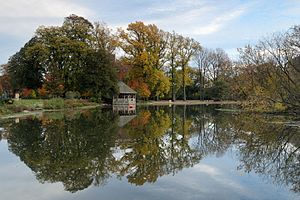
Back بروسبكت بارك Arabic Prospect Park Catalan Prospect Park (parke sa Tinipong Bansa, New York, Kings County, lat 40,66, long -73,97) CEB Prospect Park (Brooklyn) Czech Prospect Park Danish Prospect Park (Park) German Prospect Park Esperanto Prospect Park Spanish Prospect Park Estonian Prospect Park (Brooklyn) Basque
| Prospect Park | |
|---|---|
 | |
 | |
| Type | Urban park |
| Location | Brooklyn, New York City, United States |
| Coordinates | 40°39′42″N 73°58′15″W / 40.66167°N 73.97083°W |
| Area | 526 acres (2.13 km2) |
| Created | 1867–1873 |
| Owned by | NYC Parks |
| Operated by | Prospect Park Alliance |
| Visitors | about 8–10 million annually[1][2] |
| Status | Open all year |
| Public transit access | Subway and bus; see below |
| Website | www |
| Architect | Frederick Law Olmsted (1822–1903), Calvert Vaux (1824–1895) |
| NRHP reference No. | 80002637[3] |
| Significant dates | |
| Added to NRHP | September 17, 1980 |
| Designated NYCL | November 25, 1975[4] |
Prospect Park is a 526-acre (2.13 km2) urban park in the New York City borough of Brooklyn. The park is situated between the neighborhoods of Park Slope, Prospect Heights, Prospect Lefferts Gardens, Flatbush, and Windsor Terrace, and is adjacent to the Brooklyn Museum, Grand Army Plaza, and the Brooklyn Botanic Garden. With an area of 526 acres (213 ha),[5] Prospect Park is the second-largest public park in Brooklyn, behind Marine Park. Designated as a New York City scenic landmark and listed on the National Register of Historic Places, Prospect Park is operated by the Prospect Park Alliance and NYC Parks.
First proposed in legislation passed in 1859, Prospect Park was laid out by Frederick Law Olmsted and Calvert Vaux, who also helped design Manhattan's Central Park, following various changes to its design. Prospect Park opened in 1867, though it was not substantially complete until 1873. The park subsequently underwent numerous modifications and expansions to its facilities. Several additions to the park were completed in the 1890s, in the City Beautiful architectural movement. In the early 20th century, New York City Department of Parks and Recreation (NYC Parks) commissioner Robert Moses started a program to clean up Prospect Park. A period of decline in the late 20th century spurred the creation of the Prospect Park Alliance, which refurbished many parts of the park from the 1980s through the 2020s.
Main attractions of the park include the 90-acre (36 ha) Long Meadow; the Picnic House; Litchfield Villa; Prospect Park Zoo; the Boathouse; Concert Grove; Brooklyn's only lake, covering 60 acres (24 ha); and the Prospect Park Bandshell that hosts outdoor concerts in the summertime. The park also has sports facilities, including the Prospect Park Tennis Center, basketball courts, baseball fields, soccer fields, and the New York Pétanque Club in the Parade Ground. There is also a private Society of Friends (Quaker) cemetery on Quaker Hill near the ball fields. In addition, Prospect Park is part of the Brooklyn-Queens Greenway, a network of green spaces that stretch across western Long Island.
- ^ "Prospect Park Timeline". prospectpark.org. Archived from the original on May 30, 2014. Retrieved March 20, 2018.
- ^ "Millions (and millions) of visitors poured into Brooklyn Bridge Park this summer". Brooklyn Eagle. December 26, 2017. Archived from the original on July 9, 2019. Retrieved July 8, 2019.
- ^ "National Register Information System – (#80002637)". National Register of Historic Places. National Park Service. March 15, 2006.
- ^ Cite error: The named reference
nyclwas invoked but never defined (see the help page). - ^ "Prospect Park : NYC Parks". New York City Department of Parks & Recreation. June 26, 1939. Archived from the original on November 19, 2018. Retrieved January 28, 2019.
© MMXXIII Rich X Search. We shall prevail. All rights reserved. Rich X Search